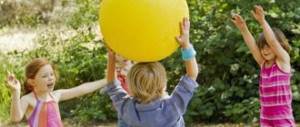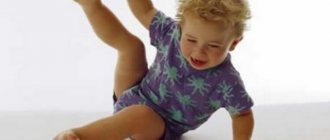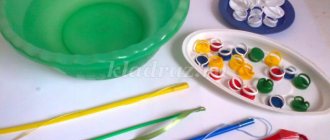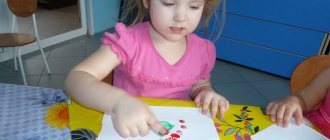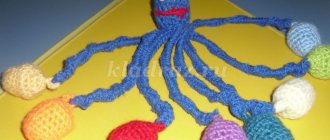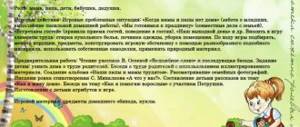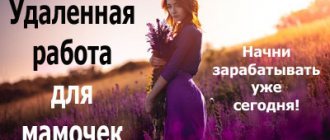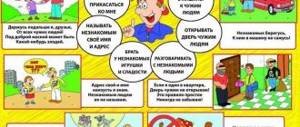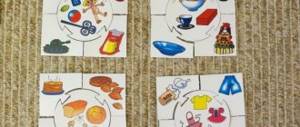Outdoor games for children from 1.5 to 3 years old
Outdoor games for children of the first junior group of a preschool educational institution
Author: Oksana Evgenievna Lashkova, teacher of the private educational institution “kindergarten No. 4” of JSC “Russian Railways”, the city of Bologoe, Tver region. Description of work : I offer you a selection of outdoor games for children of primary preschool age. This material can be used by educators and parents for conducting outdoor games in a group room, at home and on a walk, with children from 1.5 to 3 years old. This material is aimed at developing children’s interest in gaming activities, at developing such qualities as coordination of movements, speed of reaction, spatial orientation, attention. Outdoor games comprehensively develop the child and evoke positive emotions from the actions performed. Goal : To introduce kids to a variety of outdoor games.
Increase physical activity and health of children. Develop attention, coordination of movements, and the ability to navigate in space. Play occupies a significant place in the life of every child. From an early age, while playing, a child first learns to manipulate objects and studies them. With age, he looks for their connections. When playing, a child develops not only motor skills, but also thinking, imagination, and fantasy. While playing, the child builds logical chains, thinks, reflects. It is impossible to imagine a child's childhood without play. It is not for nothing that it has been noted that the way a child behaves in a game, the same way he will behave in society. Many great teachers have developed and successfully implemented a huge number of games into programs. I work with the smallest children, from one to three years old. And over the years, I have collected a card index of games, which I use in my work. These are mobile, developmental and didactic. The benefits of outdoor games in a child’s life cannot be underestimated. During active movement, metabolic processes in the body, blood circulation, and breathing are activated. In addition, outdoor games develop coordination of movements, attention and speed of reactions, train strength and endurance, and relieve impulsiveness. I suggest you familiarize yourself with the few, but my kids’ favorite, outdoor games that can be played both in a group room and on a walk. I hope this will be useful to someone in a noble cause, in the education and formation of our infinitely beautiful younger generation. Outdoor games for children from 1.5 to 3 years old.
"Sunny bunnies"
Objectives: increase motor activity, develop dexterity; evoke positive emotions from the actions performed. Having gathered a group of children around him, the teacher uses a mirror to shoot sunbeams onto the wall and say: Sunbeams are playing on the wall, lure them with your finger, they will come running to you. After a pause, he gives the signal: “Catch bunnies!” Children run to the wall and try to catch the bunny slipping from under their hands.
"Catch the ball"
Objectives: to encourage action on a signal, to improve running in combination with actions, to enjoy joint actions. The teacher shows the children a basket with balls and invites them to stand next to him along one side of the playground. Then, with the words “catch up with the ball,” he throws them out of the basket, trying to make them roll in different directions, away from the children. Children run after the balls, take them and put them in the basket. The game repeats itself.
"Collect the balls"
Objectives: increase physical activity; contribute to the emergence of positive emotions from joint actions. For the game, balls (wooden or plastic) of different colors are selected. Having put them in a basket, the teacher invites the children to see how beautiful the balls are, telling them what color they are. Then he pours them out with the words: “That’s how the balls rolled... Catch up with them and put them back in the basket.” Children run after the balls and take them to the basket. When repeating the game, the teacher names who brought which ball: red, yellow, and so on. The teacher makes sure that the children do not bunch up, but run around the entire playground (each child runs at his own pace). At first, the game is played with a small group of children, gradually the number of players increases.
"Catch me"
Objectives: improve running in a certain direction; learn to navigate in space. “Catch up with me,” the teacher suggests and runs to the opposite wall of the room. Children run after the teacher, trying to catch him. Then the teacher again says: “Catch up with me,” and runs in the opposite direction, the children catch up with him again. After two runs, the children sit on chairs and relax. Then the game resumes. It is better to play the game with small groups of children: while one group of children plays, another watches, then the children change roles.
"Cat and Mice"
Objectives: increase physical activity; develop imitation movements; arouse interest and desire to perform actions in accordance with the text. The game is played with a small group of children in the playroom or on a walk. Using a cord, a place for mice is fenced off. A cat is chosen. She sits on a chair or stump. Mice sit in minks. The teacher says: The cat is guarding the mice, Pretending to be asleep. The mice crawl out of their holes and start running. After a while, the teacher says: Hush, mice, don’t make noise, you won’t wake up the cat…. This is a signal to the cat; she gets off the chair, gets on all fours, arches her back, loudly says “meow” and begins to catch the mice as they run into their holes. The game can be repeated 3-4 times, with other cats.
"Shaggy Dog"
Objectives: enrich motor experience; encourage children to follow the basic rules of the game; encourage independence; evoke a feeling of pleasure from communicating with adults and peers, as well as from performing movements. One of the children portrays a dog; he lies down on the mat, resting his head on his outstretched arms in front of him. The rest of the children quietly approach him, and the teacher at this time says: Here lies a shaggy dog, with his nose buried in his paws, Quietly, quietly, he lies, either dozing or sleeping. Let's go up to him, wake him up and see if something happens. The dog jumps up and starts barking. The children run away. The dog is chasing them. When all the children run away and hide, the dog lies down on the rug again. The game is repeated with a new driver.
"By the Bear in the Forest"
Objectives: learn to act on the teacher’s signal, improve running in a certain direction; teach orientation in space One of the children depicts a bear; he sits on a chair, hands folded under his cheek, pretending to be asleep. The rest of the children quietly approach him, bending over, as if picking mushrooms and berries, and at this time the teacher says: From the bear in the forest, I take mushrooms and berries, But the bear does not sleep, He keeps looking at me. And then he growls. And he will run after us. The bear jumps up and runs after the children. The children run away. The bear is chasing them. When all the children run away and hide, the bear sits down on the chair again. The game is repeated with a new driver.
"Chicks and the Cat"
Objectives: improve running; develop the ability to imitate, be attentive and act on a signal; encourage independent action; evoke a feeling of joy from joint actions, teach children to run in a certain direction. The teacher depicts a chicken, the children - chickens. A cat is selected as a counting machine. The cat sits on a chair to the side. The hen and chicks walk around the room. The teacher says: A crested hen came out, There are yellow chicks with her, The hen clucks: “Ko-ko, Don’t go far.” Approaching the cat, the teacher says: On the bench by the path, the cat has laid down and is dozing... The cat opens its eyes and catches up with the chickens. The cat opens its eyes, meows and runs after the chickens, which run away to a certain corner of the room - the “house”, to the mother hen. The teacher (chicken) protects the chickens, spreading his arms to the sides, and says at the same time: “Go away, cat, I won’t give you chickens!”
"Sun and Rain"
Objectives: to develop in children the ability to run in all directions without bumping into each other, to quickly respond to a signal, to teach them to carry out actions according to an adult’s word; encourage children's independence and initiative; evoke a feeling of joy from joint actions. Children squat down behind the chairs, located at some distance from the edge of the platform or the wall of the room, and look out the “window” (into the hole in the back of the chair). The teacher says: “The sun is in the sky! You can go for a walk." Children run all over the playground. To the signal: “Rain! Hurry home! — run to their seats and sit behind the chairs. The teacher says again: “Sunny! Go for a walk,” and the game repeats.
"Blow up the bubble"
Objectives: encourage children to act in accordance with words; learn to coordinate your actions with the actions of other children; consolidate the ability to stand in a circle, gradually expanding and narrowing it; develop physical activity. Children stand close together in a circle, holding hands. Together with the teacher they say: Blow up, bubble, Blow up big, Stay like that, Don’t burst. By reciting poems, children gradually expand the circle. When the teacher says: “The bubble has burst,” all the children lower their hands, saying in unison: “Pop,” and squat down. The teacher offers to inflate a new bubble: the children stand up, form a small circle again, and the game resumes.
"Train"
Objectives: teach to move in a certain direction, coordinate actions with other children, encourage independent actions. The teacher offers to play “train”: “I will be the locomotive, and you will be the carriages.” Children stand in a column one after another, holding onto the clothes of the person in front. “Let’s go,” says the teacher, and everyone begins to move, saying: “Choo-Choo.” The teacher drives the train in one direction, then in the other, then slows down, finally stops and says: “Stop.” After a while, the whistle sounds again, and the train sets off again. Where is the bell hiding? Objectives: learn to navigate in space; develop the ability to run in different directions; evoke a feeling of joy from joint actions.
Children stand facing the wall. The nanny hides at the other end of the room and rings the bell. The teacher tells the children: “Listen to where the bell is ringing and find the bell.” When the children find the bell, the teacher praises them and then asks them to turn to the wall again. The nanny rings the bell again, hiding in a different place.
"My funny ringing ball"
Objectives: teach children to jump on two legs; learn to listen carefully to the text; evoke a feeling of joy from active actions. Children sit on chairs placed in different places in the room. The teacher is in the center. He takes a large ball and begins to hit it with his hand on the ground, saying: “My cheerful, ringing ball...”. The teacher calls the children to him and invites them to jump like balls. Children jump at the same pace. The teacher puts the ball down and repeats the poem, moving his hand as if he were hitting the ball, and the children jump. Having finished the poem, the teacher says: “I’ll catch up!” The children run away.
"The little white bunny is sitting"
Objectives: improve running; develop the ability to imitate, be attentive and act on a signal; encourage independent action; evoke a feeling of joy from joint actions. On one side of the site the places of the hares are marked. Everyone falls into place. At the teacher’s signal “Run in a circle!” all the children gather in a circle, and one of the hares, whom the teacher appoints, stands in the middle. Children with a teacher recite poems and perform movements to the text: The little white bunny sits and wiggles his ears - the children stand in a circle, Like this, this is how he wiggles his ears! – move their hands, raising them to the head. It’s cold for the bunny to sit, he needs to warm his paws, Clap-clap, clap-clap, he needs to warm his paws - they clap their hands. It’s cold for the bunny to stand, the bunny needs to jump hop-hop, hop-hop, hop-hop, the bunny needs to jump - they jump on 2 legs in place. Someone scared the bunny, the bunny jumped and galloped away! – the teacher claps his hands, the children run away to their homes.
"Birds in Nests"
Objectives: enrich motor experience; encourage children to follow the basic rules of the game; encourage independence; evoke a feeling of pleasure from communicating with adults and peers, as well as from performing movements. On one side of the playground, hoops (“nests”) are laid out freely according to the number of children. Each child (“bird”) stands in his own “nest”. At the teacher’s signal, the children - “birds” run out of the hoops - “nests” - and scatter throughout the entire playground. The teacher imitates feeding the “birds” at one or the other end of the playground: the children squat down, hitting their knees with their fingertips - they “peck” at the food. “The birds have flown to their nests!” - says the teacher, the children run to the hoops and stand in any free hoop. The game is repeated, jump twice.
"Geese - geese"
Objectives: improve running in combination with hand actions; evoke a need to imitate; enjoy joint activities. Children pretend to be geese, standing at one end of the room, and an adult stands at the other end. They take turns saying: Adult: Geese, geese! Children: Ha-ha-ga! Adult: Do you want something to eat? Children: Yes, yes, yes! Adult: Come to me! The geese children fly towards the adult, flapping their wings, hissing: “Sh-sh-sh.” Then the adult says: “Ksh! Run into the field!” The geese run back to their place.
"Birds and Cars"
Objectives: improve walking in different directions, on a limited surface; develop attention and the ability to respond to signals; encourage active interaction with peers. All children pretend to be birds. The role of the car is initially played by the teacher. He says: “The birds have flown out for a walk.” Bird children fly around the group, flapping their wings, pecking at grains. At the teacher’s signal “Car!” The birds quickly run away from the road. One part of the children is placed on one side of the group; the playgrounds are birds. On the other side there is another part of the children - these are cars. The teacher says: “The birds are flying!” — the birds fly, flap their wings, squat, peck grains. At the signal “Cars have left!” children pretending to be cars drive onto the road, and birds fly away to their nests. Cars drive along the road, avoiding obstacles (benches, cubes). When repeating the game, children change roles.
"Carousels"
Objectives: develop balance, learn to coordinate your actions with the words of the text, with movements with each other and the rhythm of the text; develop attention; evoke positive emotions. Children take hold of the hoop and, following the words of the teacher, move in a circle, first slowly, then faster and faster, and then gradually slow down. Barely, barely, barely, barely The carousel spun, And then, then, then Everyone ran, ran, ran. Hush, hush, don't rush, stop the carousel. One-two, one-two, The game is over.
"Present"
Objectives: to cultivate friendly, benevolent relationships; learn to imitate movements characteristic of a particular toy; develop imagination. The teacher invites the children to form a circle and calls to him the one who will be the first to choose a toy. The child goes to the middle of the circle, and the teacher and the children dance in a circle to the words: We brought you gifts, Whoever wants it will take it, Here is a doll with a bright bow, A horse, a top and an airplane. When the words end, the children stop. The teacher turns to the child in the center of the circle and asks which gift (from those listed) he wants to receive. If he chooses a horse, then all the children, following the words of the teacher (our horse gallops chok-chok-chok, you can hear the clatter of fast legs), pretend to be a horse (jump), if a doll, then everyone dances like dolls (doll. Doll dance, wave a bright ribbon ) if the top (this is how a top spins, it buzzes and rolls) - everyone spins. The teacher invites the child to choose the best “gift” from among the children. The selected child changes the previous one in the center and the game repeats.
We recommend watching:
Water games for the second younger group. Card index Educational game for children of the 1st junior group in kindergarten Picture puzzles with answers for elementary school students Games with pebbles for children of the junior group in kindergarten
Similar articles:
Playing with sand in the younger group
Drawing games for preschoolers 3-5 years old
Outdoor games in the second junior group
Role-playing family games for children of the younger group
Role-playing games in the younger group on the topic: Animals
CHILDHOOD GUIDE
Games for a walk with children 2-3 years old
Mosienko Elena Yurievna,
teacher of MKDOU No. 16,
Novosibirsk city
What to play with your child on the street? Simple and affordable outdoor games for children aged 2 to 3 years:
Catch-up
Catch-up is one of the most favorite children's games. In order for a 2-year-old child to be interested in playing them, catch-up games must be role-playing . Mom can become a cat, and the baby can become a mouse. You can also play as a wolf and bunnies, as children and a bear, as chickens and a fox. If you play catch for the first time, the baby needs to be taught to play this game, because, as a rule, if a 2-year-old child simply says “let me be the cat, and you the mouse,” he will look at you with interest and wait , What will be next.
And then you can do this: Mom begins to pretend to be a hungry cat. “Ugh! I'm a cat! Meow! Meow! That's how I meow! Oh, and I'm hungry! Where are the mice! Now I will eat you!” The mother, with cheerful sentences, runs up to the baby and begins to lightly tickle him. Most children run away from such a tickling cat with laughter, and the game of “catch up” comes naturally.
Game “Run to what I name”
This game is very simple and accessible for kids. It teaches the child how to navigate in space, and of course gives him an excellent opportunity to move around. The mother announces to the child: “Let’s be cars!” (or trains). When pretending to be a car, you can stand still and hum like a car engine and “beep.” Then mom announces: “Now, cars, let’s go to the slide!” All the “cars” are “going” to the hill. “And now to the house!” Children move to the house, etc.
If the baby is standing still and not running anywhere, you can help him - take his hand and run with him. Gradually he will get involved in the game and begin to play on his own.
Game "Birds"
Children and their mother run around the playground and pretend to be birds - flapping their wings, squatting, “pecking grains.”
Suddenly mom shouts “Oh! The cat is coming, let’s hide in the house!” The children run with their mother to a house or other shelter on the playground. Then mom announces that the cat has left and you can go for a walk again.
Jumping over bumps
Mom draws geometric shapes (circles, squares, etc.) on the ground. You can draw with crayons on the asphalt or with a stick on the ground. These will be “bumps”. On the farthest “bump” the mother places some object, for example, a bucket of molds. The mother explains to the child that he will now go on a hike to get the bucket, but he must only walk over the bumps. The baby begins to move, moving, placing his feet on the drawn “bumps”.
This game develops coordination well.
Accuracy game
If you play this game in the forest on a picnic, then pine cones and wood are perfect for it. On the playground you can play with balls or any other objects. Children and their mother stand a short distance from some object (slide, tree, etc.) and begin to throw objects in order to hit it.
This game develops accuracy.
Sweep the path
This game is very simple, but for some unknown reason, children really like it. Mom makes something like a broom out of twigs or sticks (one for herself and the other for the kids) and invites them to sweep the path. Usually children respond to this “request” with great pleasure.
Loaf
“Loaf” is a wonderful game from our childhood. Children over 2.5 years old enjoy playing it. Mothers and babies stand in a round dance, one baby is led into the round dance. Walking in a circle, participants sing a song:
| Like on Car’s name day, we baked a loaf, | The players dance in a circle, and instead of the name “Masha” they say the name of the baby who remains in the circle. |
| Such a height | The players stop. Without releasing your arms, raise them up. |
| Such lows | Without releasing your hands, lower them down. |
| This is the width | Stretch the hands clasped in a round dance to the sides, make the round dance as wide as possible. |
| These are the dinners. | Without releasing your hands, direct them to the center and try to make a circle of your hands as narrow as possible. |
| Loaf, loaf, choose whoever you want! | They clap their hands. |
| Of course, I love everyone, but Vanya most of all! | The leader pronounces these words together with the baby standing in a circle. Instead of the name “Vanya,” the name of someone who is standing in a round dance is pronounced. The named baby changes places with the participant who was standing inside the circle, and the round dance game continues. |
This game seems simple and uncomplicated, but this is precisely why children from 2 to 3 years old play it with great pleasure.
Drivers
This is a simple role-playing game. The adult and children become the “drivers” of the car. They pick up a “steering wheel” (something round, such as a bucket or sieve), and begin to make sounds similar to the hum of a car engine. Turning the steering wheel, the “drivers” move around the site, drive into the garage, “fill up” with gasoline, and stop by for “repairs.”
Aircraft
The game is similar to the previous one. Adults and children become airplanes. First, the “airplane” starts the propeller (makes circular movements with its hand), and then spreads its “wings” and flies (moves in different directions around the site).
Along the path
Mom draws a winding line on the ground (with chalk on the asphalt, with a stick on the ground). The line will be our path. At the end of the “track” you can put some object - a beautiful mold, a spatula. The child is asked to walk to the object along the path, trying not to leave it.
Towns
An adult places several objects on top of each other to create a “tower”. The kid is given a ball and asked to throw it so that the tower collapses. Gradually the distance to the turret is increased.
Sunny bunny
Mom lets out a sunbeam with the help of a mirror. The baby is asked to catch it with his hand or foot.
"Geese, geese"
A wonderful children's game. You will need several children to play. Since very young children will be playing, it will be better for mothers to pretend to be “geese” with them.
Children and mothers line up in a row. The leader stands at a distance of several meters from them, he will be a wolf.
The presenter says: “Geese, geese.”
Children: "Ha, ha, ha."
Host: “Do you want to eat?”
Children: “Yes, yes, yes.”
Presenter: “Well, fly if you want, just take care of your wings.”
The children run to the other end of the playing field, and the leader tries to catch the goslings.
Mice dance in circles
The children stand in a round dance, the leading “cat” stands inside. The children walk in a circle and tell a nursery rhyme. Since the kids will be playing, the round dance takes place together with the mothers, and the mothers also participate in the game. The nursery rhyme can be said by the cat himself or by a second adult.
The mice dance in circles.
The cat is dozing on the bed.
“Hush, mice, don’t make noise,
Don't wake up Vaska the cat.
How Vaska the cat wakes up...
He’ll break up our round dance!”
In the last words, “the cat wakes up” and catches “mice.” To make it easier to escape from the cat, you can agree that the mice can hide in “houses” - circles drawn on the asphalt or a house on the playground.
Do you play outdoor games with your kids?
Share your invaluable experience of outdoor games in the comments to this article! Games during the adaptation period with children two to three years old Educational games for children 2-3 years old What to write in self-analysis about partner interaction with children Using self-massage in working with children in a speech therapy group >
Card file of walks in an early age group
Card file of walks in an early age group
Senior teacher
CARD #1. *AUTUMN* OBSERVATION: Sand observation. Properties of sand: dry sand is crumbly, but wet sand retains the shape of the object into which it was poured. You can make “pies”, “Kulichiki”, “mound houses” from sand. You can draw on the sand with a stick “Let’s draw on the sand.” INDIVIDUAL WORK: Drawings with a stick in the sand (circles, houses, etc.) OUTDOOR GAMES: “Cat and Mice.” Exercise children in crawling (or crawling), the ability to respond to a signal, and perform movements in accordance with the text of the poem. “The cat was guarding the mice, pretending to be asleep. Quiet, mice, don’t make noise, you won’t wake the cat...” PLOT-ROLE-PLAYING GAMES: “Hospital” Distribution of roles, ability to use substitute items, bring the game to its logical end. INDEPENDENT GAMES: Children play with external materials, learning the ability to use a scoop and mold correctly. WORK: Collecting sand in a sandbox.
CARD #2. *AUTUMN* OBSERVATION: Looking at the flowers in the flowerbed. The flowers are beautiful, delicate, fragrant, of different colors, large and small. You can make a bouquet from flowers. INDIVIDUAL WORK: Didactic game “Find a similar leaf or flower” ACTIVE GAMES: “Walk through the stream” Develop children’s sense of balance, dexterity, and eye. STORY-ROLE-PLAYING GAMES: “Builders” Take-out material, teach children to use substitute objects, make a building out of sand and INDEPENDENT GAMES: Children’s games with take-out material. The combination of sand with building and natural materials allows you to build interesting and complex buildings. LABOR: Cleaning the area of stones.
CARD #3. *AUTUMN* OBSERVATION: Observation of weather conditions (sun shining or raining). Listening to the story about the golden autumn, children note the warmth of the gentle sun and the blue sky and slowly floating clouds. INDIVIDUAL WORK: Walks along the path to the rhythm of the nursery rhyme: “Big feet walked along the road... tramp, tramp, tramp Little legs ran along the path... tramp, tramp, tramp. OUTDOOR GAMES: “Beetles” Exercise children in running in loose areas, changing movements when given a signal, and being attentive. STORY-ROLE-PLAYING GAMES: “Shop” Teach children to use substitute objects in the game. INDEPENDENT GAMES: Create conditions for the development of creative play (selection of small toys and objects, as well as the wide inclusion of natural materials). LABOR: Cleaning the area. Collecting sand in a sandbox.
CARD #4. *AUTUMN* OBSERVATION: Observation of a tree. Teach children to distinguish trees from other plants. Describe them: tall, beautiful, many leaves of different colors (green, yellow, red). INDIVIDUAL WORK: Learn with children the poem “We’ll bake a pie from sand” “We’ll bake a pie from sand, We’ll invite mom to visit, We’ll invite you too, friends, But you can’t eat the pie. ACTIVE GAMES: “Shaggy Dog” To teach children to listen to the text and quickly respond to the signal. “Here lies a shaggy dog, with his nose buried in his paws, Quietly, quietly, he lies, either dozing or sleeping. Let's go up to him, wake him up, and see if something happens. STORY-ROLE-PLAYING GAMES: “Family” Distribution of roles, bringing the game to its logical conclusion. INDEPENDENT GAMES: Children play with external materials, learning the ability to use a scoop and mold correctly. LABOR: Cleaning the area from sticks.
CARD #5. *AUTUMN* OBSERVATION: Observation of a cat. The cat is kind, affectionate, calm, says “Meow-Meow.” A cat has ears, paws, a head, a tail, and fur. Together with the teacher, they show and name everything that the cat has. The cat sleeps, washes itself, drinks milk. At the teacher’s suggestion, play the game “Treat the pussy with milk.” INDIVIDUAL WORK: Game exercise “Walk and don’t knock down” (skittles). Develop a sense of balance and dexterity. OUTDOOR GAMES: “Where is it ringing?” develop children's attention and spatial orientation. PLOT-ROLE-PLAYING GAMES: “I am the driver” Development of dialogic speech, memory, game management, distribution of roles. INDEPENDENT GAMES: Children playing with outside materials, learning how to properly use a scoop and mold, making Easter cakes WORK: Collecting sand in a sandbox.
CARD #6. *AUTUMN* WATCHING: Watching water in warm weather. Properties of water: pours, can be cold or warm, toys can float in the water. INDIVIDUAL WORK: Offer a game: catching multi-colored balls from a basin with a sap (the balls float - we catch the balls with nets). OUTDOOR GAMES: “Airplanes” Exercise children in the ability to run without bumping into each other, and perform movements on a signal. “We stomp our feet: stomp stomp stomp We clap our hands: clap-clap-clap, Shake our heads, shake our heads. We raise our hands, we lower our hands, we hand out our hands, and we run around. STORY-ROLE-PLAYING GAMES: “Hospital” Distribution of roles, ability to use substitute items, bring the game to its logical conclusion. SELF-GAMES: Offer to draw with a stick in the sand. Games with external material. WORK: Cleaning toys from the site.
CARD No. 7. *AUTUMN* OBSERVATION: Observation of the work of a janitor. What it does: rake leaves, sweep paths, collect trash. What does the janitor have (broom, rake, trash can). INDIVIDUAL WORK: Rolling the ball in a straight line. Learn to push the ball with both hands. OUTDOOR GAMES: “Birds in nests” Exercise children in running in different directions, in the ability to hear the teacher’s signal, in spatial orientation. STORY-ROLE-PLAYING GAMES: “Builders” Take-out material, teach children to use substitute objects, make a building out of sand. INDEPENDENT GAMES: Create conditions for the development of creative play (selection of small toys and objects, as well as the wide inclusion of natural materials). LABOR: Collect sticks and dry leaves from the area.
CARD No. 8. *AUTUMN* OBSERVATION: Wind observation. The wind is strong, cold, shaking the trees. Blows on the leaves and tears them off. The wind blows on the turntable, it spins. Invite the children to blow on the pinwheel like a breeze. INDIVIDUAL WORK: Pronunciation of sounds. Like a steam locomotive hums, “Like a car hums.” ACTIVE GAMES: “Children and the Wolf” Exercise children to quickly respond to a signal, run and dodge. “The children walked through the forest, picked strawberries, a lot of berries everywhere - both on the hummocks and in the grass. But then the branches began to crack... Children, children, don’t yawn, The wolf is behind the spruce - run away! STORY-ROLE-PLAYING GAMES: “Shop” Teach children to use substitute objects in the game. Development of dialogical speech. INDEPENDENT GAMES: Children's games with external material. WORK: Collecting sand in a sandbox.
CARD No. 9. *AUTUMN* OBSERVATION: Bird watching (crow, pigeons, sparrows). What they do: fly, sit on tree branches, jump, peck grains, small pebbles. What do birds have: beak, feathers, wings, eyes, legs. The crow is big and important. The sparrow is small and fast. The dove is large and calm. INDIVIDUAL WORK: Offer to feed the birds some bread. OUTDOOR GAMES: “Sparrows and a car” Exercise children in running in different directions without bumping into each other, in the ability to start moving and change it at the teacher’s signal, and find their place. STORY-ROLE-PLAYING GAMES: “Family” Distribution of roles, bringing the game to its logical conclusion. INDIVIDUAL GAMES: Using a stick or chalk, draw (puddles, sun, house, fence). WORK: Collecting toys on the site.
CARD No. 10 *AUTUMN* OBSERVATION: In calm, sunny weather, pay attention to the colorful leaves. Offer to wander through the fallen leaves, listening to how they rustle under your feet. Offer to collect leaves, clarify with each child the colors (red, yellow), whether the leaves are large or small. Collect in a bouquet. INDIVIDUAL WORK: Learn the poem with children: “Hello Autumn, hello Autumn!” It's good that you came. We, Autumn, will ask you, What did you bring as a gift?” OUTDOOR GAMES: “Bubble” To strengthen in children the ability to stand in a circle, gradually expand and narrow it. “Inflate, bubble, inflate, big, Stay like that, but don’t burst.” STORY-ROLE-PLAYING GAMES: “Transport” External material: steering wheels, traffic signs. Remember the rules of the road. INDEPENDENT GAMES: games with external material. WORK: Cleaning toys from the site. Collecting sand in a sandbox.
CARD No. 11. *WINTER* OBSERVATION: In inclement weather, observation from the window: it is raining, you cannot walk. The rain is wet, dripping on the ground, on the plants, everything is damp on the paths. People walk under umbrellas. INDIVIDUAL WORK: Learning the nursery rhyme “Rain, rain” “Rain, rain, why are you pouring, won’t you let us take a walk?” OUTDOOR GAMES: “The gray bunny washes itself” Accustom children to listen to the text and perform movements in accordance with the content, pay special attention to performing jumps. “The gray bunny is washing his face, apparently getting ready to visit. He washed his nose, washed his tail, washed his ear, wiped it dry!” PLOT-ROLE-PLAYING GAMES: “I am the driver” Development of dialogic speech, memory, game management, distribution of roles. INDEPENDENT GAMES: Children's games with external material. WORK: Cleaning toys from the site.
Get full text
CARD No. 12. *WINTER* SURVEILLANCE: Observation of a vehicle (truck). Invite children to watch a moving car. Tell that the car does not drive itself, it is driven by the driver. A car has a body, a cabin, a wheel, and a steering wheel. This car is big, it’s a truck, it carries cargo, it drives along the road, it can make a horn. INDIVIDUAL WORK: d/i.: “How does the car hum?” Reinforce the pronunciation of consonant sounds. Working on strength and voice volume. OUTDOOR GAMES: “Train” to teach children to walk and run after each other in small groups. First holding each other, then not holding each other. Action on signal. STORY-ROLE-PLAYING GAMES: “Hospital” Distribution of roles, ability to use substitute items, bring the game to its logical conclusion. INDEPENDENT GAMES: independent games with external material. WORK: Cleaning up trash from the site.
CARD No. 13. *WINTER* OBSERVATION: Watch the first snowflakes swirl. Ice appears on the puddles. What kind of snow: white, fluffy, cold. Why does it melt immediately? INDIVIDUAL WORK: Learning the poem “Snow” by M. Poznamskaya “Quietly - quietly the snow is falling, white shaggy snow. We will shovel away the snow and ice in the yard.” OUTDOOR GAMES: “We will build a big house.” Teach children to listen to the text and perform movements in accordance with the content. “We will build a big house, we will all live in it together, the children gather, the doors close. The doors open, the fairy tale begins. Knock-knock-knock, knock-knock-knock! Who's suddenly knocking on the door? Maybe a bunny came to the house? Maybe a clumsy bear? Maybe a red fox? What miracles! STORY-ROLE-PLAYING GAMES: “Builders” Takeaway material, teach children to use substitute objects. INDEPENDENT GAMES: games with external material. WORK: Cleaning toys on the site.
CARD No. 14. *WINTER* OBSERVATION: To form children’s idea of winter. On a sunny day, pay attention to the beauty of the winter landscape (it’s white and light all around, the snow sparkles in the sun, the sky is blue). Note what kind of sun it is (bright, covered by clouds). INDIVIDUAL WORK: Jumping on two legs with forward movement. Learn to push off and maintain balance. ACTIVE GAMES: “Crows” Children pretend to be crows, imitate the teacher, and act on a signal. “Here, under the green Christmas tree, the crows are jumping merrily Kar - kar - kar! They screamed all day long and didn't let the boys sleep. Kar - kar - kar! Only towards night they fall silent and everyone falls asleep together. Kar - kar - kar! (quietly) ROLE-PLAYING GAMES: “Shop” Teach children to use substitute objects in the game. Development of dialogical speech. INDEPENDENT GAMES: Children's games with external material. LABOR: Clear the area of snow.
CARD #15. *WINTER* OBSERVATION: We observe the wind, introduce children to such phenomena as “blizzard” and “blizzard”. Watch the low and fast floating clouds and swaying tree branches. INDIVIDUAL WORK: “What is the wind?” strong, cold. “How does the wind sing?” children imitate the hum of the wind. Expanding vocabulary. ACTIVE GAMES: “Aim more accurately” Exercise children in throwing at a horizontal target. Develop dexterity, eye, coordination of movements. STORY-ROLE-PLAYING GAMES: “Family” Distribution of roles, bringing the game to its logical conclusion. INDEPENDENT GAMES: Build a slide, games with external materials. To make a snowman. WORK: Collecting toys on the site.
CARD No. 16. *WINTER* OBSERVATION: Observation of the work of a janitor. To develop respect for the work of adults, to create a desire to come to the aid of others. There is a lot of snow on the site, the paths are covered with snow. A janitor shovels snow. Children are sledding. INDIVIDUAL WORK: d/i “Who needs what for work” on the topic “Profession”. To consolidate children's knowledge that different things and tools help people in their work. OUTDOOR GAMES: “Tracks” teach children to run after each other, making difficult turns, maintain balance, not interfere with each other and not push the person running in front. STORY-ROLE-PLAYING GAMES: “Transport” External material: steering wheels, traffic signs. Remember the rules of the road. INDEPENDENT GAMES: independent games with external material. Drawings on the snow with colored water. LABOR: Clear the area of snow.
CARD No. 17. *WINTER* OBSERVATION: We watch the trees. Show the children trees: birch, spruce, and make out their distinctive features. Note that the birch tree has dropped its leaves for the winter. INDIVIDUAL WORK: Exercise to develop fine motor skills of the hands: assemble a broom from twigs. ACTIVITY GAMES: “Crow and Dog” Teach to imitate the movements and sounds of birds, to move without interfering with each other. “Near the green Christmas tree, crows are jumping and cawing: Kar! Kar! Kar! Then the dog came running, and the crow scared everyone away: Aw! Aw! Aw!” PLOT-ROLE-PLAYING GAMES: “I am the driver” Development of dialogic speech, memory, game management, distribution of roles. INDEPENDENT GAMES: Children's games with external material. WORK: Cleaning toys from the site.
CARD #18. *WINTER* OBSERVATION: Studying transport. Strengthen children's knowledge about vehicles. Draw children's attention to nearby vehicles. Fix the names of the machine parts. INDIVIDUAL WORK: p/i.: “On the highway” Develop coordination of words with movements, develop creative imagination, achieve automation of hissing sounds. “Cars are rushing along the highway. - Shhh! – the tires rustle calmly. And hiss with anger: “Don’t rush on the turn.” A hedgehog with a bag and a staff walks along the highway. OUTDOOR GAMES: “Walk through the stream” To develop children’s sense of balance, dexterity, and eye. STORY-ROLE-PLAYING GAMES: “Hospital” Distribution of roles, ability to use substitute items. INDEPENDENT GAMES: independent games with external material. WORK: Cleaning up trash from the site.
CARD No. 19. *WINTER* OBSERVATION: “Wintering birds” Sparrows (crows, pigeons) flew into the area. Sparrows are small, fly quickly, and look for food. In winter, people make bird feeders to feed the birds. INDIVIDUAL WORK: Feed the birds with the children, hang a feeder. ACTIVE GAMES: “Train Train” Teach children to move in different directions, show objects, convey the characteristic movements of birds. “Choo-choo! Chug-chug” The train rushes at full speed. The locomotive blew its whistle and the carriages rolled away; I puff, puff, puff. I drag a hundred carriages. Choo-choo! Choo-choo! I'll take you far! We've arrived! - Steam locomotive, steam locomotive, what did you bring us as a gift? - Balls! STORY-ROLE-PLAYING GAMES: “Builders” Takeaway material, teach children to use substitute objects. INDEPENDENT GAMES: Children's games with external material. WORK: Cleaning toys from the site.
CARD #20. *WINTER* OBSERVATION: Observing the clothes of passers-by. Draw the children's attention to the fact that winter has come, it has become cold, people put on warm hats, coats, boots. In such clothes people are not cold, but warm. Invite the children to talk about their clothes, what they are wearing. INDIVIDUAL WORK: Learning the poem: “I put on a glove, I don’t fall into it! Guys, count how many fingers the glove has. We begin to count out loud: “One, two, three, four, five!”” ACTIVITY GAMES: “Bubble” To strengthen in children the ability to stand in a circle, gradually expand and narrow it. “Inflate, bubble, inflate, big, Stay like that, but don’t burst.” STORY-ROLE-PLAYING GAMES: “Shop” Teach children to use substitute objects in the game. Development of dialogical speech. INDEPENDENT GAMES: independent games with external material. To make a snowman. WORK: Cleaning up trash from the site.
CARD No. 21. *SPRING* OBSERVATION: “Spring has come” Give an idea of early spring, what changes have occurred with the sun. Observing the sun: it shines brightly, warms the earth, warms the plants. The days have become longer, the evenings are lighter. INDIVIDUAL WORK: Drawings on the snow with colored water. OUTDOOR GAMES: “Spring”. Coordination of speech with movement, development of general speech skills. “Sunshine, sunshine, golden bottom. Burn, burn clearly, so that it doesn’t go out, A stream ran in the garden, a hundred rooks flew in, And the snowdrifts melted, melted, and the flowers grew.” STORY-ROLE-PLAYING GAMES: “Hospital” Distribution of roles, ability to use substitute items, bring the game to its logical conclusion. INDEPENDENT GAMES: games with external material. WORK: Cleaning toys on the site.
CARD No. 22. *SPRING* OBSERVATION: Observation of the sky and clouds. Reinforce the idea of spring. Pay attention to the changes that have taken place in the sky. What a sky: blue, clouds appeared. INDIVIDUAL WORK: Draw clouds on the snow with a stick. ACTIVE GAMES: “Birds in nests” Exercise children in running in different directions, in the ability to hear the teacher’s signal, and navigate in space. STORY-ROLE-PLAYING GAMES: “Transport” External material: steering wheels, traffic signs. Remember the rules of the road. INDEPENDENT GAMES: Children's games with external material. WORK: Cleaning toys on the site.
CARD No. 23. *SPRING* OBSERVATION: Watching the snow. Spring has come, when the sun warms up, the snow begins to melt, it drips from the roof - this is also melting snow. Conduct an experiment. Take the snow in your hand, the snow melted from the heat. INDIVIDUAL WORK: Learning the poem by I. Tokmakova: “Spring is coming towards us with quick steps, And the snowdrifts are melting under her feet.” OUTDOOR GAMES: “The further you throw, the closer you run” Exercise children in running races, in throwing a projectile, and in speed. PLOT-ROLE-PLAYING GAMES: “I am the driver” Development of dialogic speech, memory, game management, distribution of roles. INDEPENDENT GAMES: Games with external material. WORK: Collecting toys on the site.
CARD No. 24 *SPRING* OBSERVATION: Observation of precipitation. It is raining (heavy, not heavy). There are puddles on the paths from the rain, the leaves on the trees and bushes are wet. The birds hid from the rain. It's warm outside because it's spring, the rain is warm. INDIVIDUAL WORK: p/i “Streams by the Lake” Teach to run after each other in small groups, stand in a circle. OUTDOOR GAMES: “Beetles” Exercise children in running in loose areas, changing movements when given a signal, and being attentive. STORY-ROLE-PLAYING GAMES: “Hospital” Distribution of roles, ability to use substitute items. INDEPENDENT GAMES: independent games with external material. WORK: Cleaning toys from the site.
Get full text
CARD #25. *SPRING* OBSERVATION: Bird watching (crow, sparrow, pigeon). They are glad that it has become warm. They chirp merrily, hatch eggs (crows) so that there will be chicks. They dig up and peck the worms. Discuss the body structure of a bird. INDIVIDUAL WORK: Invite children to feed the birds. OUTDOOR GAMES: “Birds one” Birds two!” Teach children to perform counting movements. “How many legs, eyes, wings does a bird have?” “Birds again!” Two birds! Hop, hop, hop! Birds once! Two birds! Clap, clap, clap! Birds once! Two birds! That's it, they've flown away! STORY-ROLE-PLAYING GAMES: “Builders” Takeaway material, teach children to use substitute objects. INDEPENDENT GAMES: Children's games with external material. WORK: Cleaning toys from the site. Clear the ground of old leaves.
CARD No. 26. *SPRING* OBSERVATION: Observing changes in nature. The first leaves are blooming on the trees. The first flowers bloomed, people took off their jackets and hats. INDIVIDUAL WORK: d/i.: Repeat the names of the trees. Discuss the structure of a tree (trunk, branches, leaves) ACTIVITY GAMES: “Shaggy Dog” Teach children to listen to the text and quickly respond to the signal. “Here lies a shaggy dog, with his nose buried in his paws, Quietly, quietly, he lies, either dozing or sleeping. Let's go up to him, wake him up, and see if something happens. STORY-ROLE-PLAYING GAMES: “Shop” Teach children to use substitute objects in the game. Development of dialogical speech. INDEPENDENT GAMES: independent games with external material. WORK: Cleaning up trash from the site.
CARD No. 27. *SPRING* OBSERVATION: Repeat the signs of spring. Pay attention to the thawed areas, green grass has already appeared there. Offer to run your palm over the grass - it is soft. INDIVIDUAL WORK: Learn the nursery rhyme “Rain, rain, more!” The grass will be thicker!” OUTDOOR GAMES: “The Herd” Teach children to quickly respond to a signal. “Shepherd boy, little shepherd boy, play the horn! The grass is soft, the dew is sweet. Drive the herd into the field for a walk in the wild.” STORY-ROLE-PLAYING GAMES: “Family” Distribution of roles, bringing the game to its logical conclusion. INDEPENDENT GAMES: Build a slide, games with external materials. LABOR: Clear the area of last year's leaves with a rake.
CARD No. 28 *SPRING* OBSERVATION: Observation of the wind. What type of wind is blowing: strong, not very strong wind. When the wind blows, the trees sway and the plumes rustle. The wind can be cold or warm. INDIVIDUAL WORK: p/i “Birds in nests” Exercise children in running in different directions, in the ability to hear the teacher’s signal, and navigate in space. OUTDOOR GAMES: “Walk through the stream” To develop children’s sense of balance, dexterity, and eye. STORY-ROLE-PLAYING GAMES: “Transport” External material: steering wheels, traffic signs. Remember the rules of the road. INDEPENDENT GAMES: independent games with external material. WORK: Cleaning toys from the site.
CARD No. 29. *SPRING* OBSERVATION: We observe the work of the janitor. Teach to respect the work of an adult. Pay attention to the fact that the janitor is cleaning the lawns. What tools does a janitor have? INDIVIDUAL WORK: Learning the poem: “The janitor will get up at dawn and clean everything in the yard. And he will trim the bushes himself, Beauty is our joy! OUTDOOR GAMES: “Slippers” Practice hitting the ball. PLOT-ROLE-PLAYING GAMES: “I am the driver” Development of dialogic speech, memory, game management, distribution of roles. INDEPENDENT GAMES: Children's games with external material. WORK: Cleaning toys from the site.
CARD #30. *SPRING* OBSERVATION: We observe work in the flower beds and in the vegetable garden. Introduce children to the rules of sowing seeds in the vegetable garden and flower garden. Teach to respect the work of adults. INDIVIDUAL WORK: Consider seeds of different colors. Offer to sow flower seeds in the flower bed. OUTDOOR GAMES: “Sunshine and Rain” Teach children to walk and run in all directions without bumping into each other, teach them to act on a signal. STORY-ROLE-PLAYING GAMES: “Hospital” Distribution of roles, ability to use substitute items. INDEPENDENT GAMES: independent games with external material. WORK: Collecting sand in a sandbox.
CARD No. 31. *SUMMER* OBSERVATION: Watching the sun. Give children an idea of the weather conditions in summer. Fix the names of seasonal clothing. Note that the sun is hotter in the summer, so children walk around naked. INDIVIDUAL WORK: Learning the poem by A. Barto: “The sun looks out the window, shines into our room. We will clap our hands - we are very happy about the sun.” OUTDOOR GAMES: “Cat and Mice”. Exercise children in crawling (or crawling), the ability to respond to a signal, and perform movements in accordance with the text of the poem. “The cat was guarding the mice and pretended to be asleep. Hush, mice, don’t make noise, you won’t wake the cat...” STORY-ROLE-PLAYING GAMES: “Builders” Take-out material, teach children to use substitute objects. INDEPENDENT GAMES: Games with external material. WORK: Collecting toys on the site.
CARD No. 32 *SUMMER* OBSERVATION: Observation of the sky and clouds. Explain the concept of “cloud”, the dependence of weather on the presence of clouds. Notice that the clouds are moving, sometimes they move slowly, sometimes they move quickly. INDIVIDUAL WORK: “Draw on the sand” Draw a cloud on the sand. OUTDOOR GAMES: “Get into the circle” Develop your eye, the ability to balance your strength when throwing. STORY-ROLE-PLAYING GAMES: “Shop” Teach children to use substitute objects in the game. Development of dialogical speech. INDEPENDENT GAMES: independent games with external material. WORK: Collecting sand in a sandbox.
CARD No. 33. *SUMMER* OBSERVATION: Watching the wind. Repeat the concept of “wind”. What happens to trees in windy weather. Learn the poem: “Wind, wind! You are powerful, you drive away flocks of clouds, you stir the blue sea, you blow everywhere in the open space...” INDIVIDUAL WORK: d/i. “Blow like the wind” Practice the strength of your voice, the ability to take a deep breath through your nose, exhale through your mouth while pronouncing the sound [u]. OUTDOOR GAMES: “Airplanes” Exercise children in the ability to run without bumping into each other, and perform movements on a signal. “We stomp our feet: stomp stomp stomp We clap our hands: clap-clap-clap, Shake our heads, shake our heads. We raise our hands, we lower our hands, we hand out our hands, and we run around. STORY-ROLE-PLAYING GAMES: “Family” Distribution of roles, bringing the game to its logical conclusion. INDEPENDENT GAMES: Children's games with external material. WORK: Cleaning toys from the site.
CARD No. 34. *SUMMER* OBSERVATION: We watch rain, thunderstorms and rainbows. To consolidate summer seasonal signs and changes occurring in inanimate nature. Watch the first summer rain with your children. Listen to the rain knocking on the windows, watch the water flow down in streams, see the puddles on the asphalt. INDIVIDUAL WORK: Learning the nursery rhyme: “Rainbow - arc! Don't let it rain! Come on, sunshine - bell!" OUTDOOR GAMES: “Sunshine and Rain” Develop in children the ability to play loosely, without bumping into each other. Respond quickly to a signal. STORY-ROLE-PLAYING GAMES: “Transport” External material: steering wheels, traffic signs. Remember the rules of the road. INDEPENDENT GAMES: independent games with external material. WORK: Cleaning up trash from the site.
CARD #35. *SUMMER* OBSERVATION: We study trees and shrubs. Remember what a birch tree looks like, introduce spruce, aspen, lilac (structure, benefits, changes that occur with the arrival of summer). Pay attention to the birch tree, it is especially dear to our people. INDIVIDUAL WORK: “Lay out a pattern” Lay out a pattern from wooden sticks or matches. Collection of natural materials. OUTDOOR GAMES: “The Corydalis Hen” Exercise children to quickly respond to the signal to run and dodge “A Corydalis Hen came out, with yellow chicks, The chicken clucks: Ko-Ko, don’t want to go far. On a bench by the path a cat lay down and dozed. The cat opens its eyes and catches up with the chicken.” PLOT-ROLE-PLAYING GAMES: “I am the driver” Development of dialogic speech, memory, game management, distribution of roles. INDEPENDENT GAMES: Games with external material. WORK: Collecting toys on the site.
CARD No. 36 *SUMMER* OBSERVATION: What blooms in summer. Introduce some flowering herbaceous plants. Disassemble their structure, talk about the benefits of flowers. INDIVIDUAL WORK: p/i “Aim more accurately” Exercise children in throwing at a horizontal target. Develop dexterity, eye, coordination of movements. OUTDOOR GAMES: “Beetles” Exercise children in running in loose areas, changing movements when given a signal, and being attentive. STORY-ROLE-PLAYING GAMES: “Hospital” Distribution of roles, ability to use substitute items. INDEPENDENT GAMES: independent games with external material. WORK: Cleaning toys from the site.
CARD No. 37. *SUMMER*
OBSERVATION: Studying sand and soil. Identify the properties of sand and soil, their similarities and differences. Compare the color of dry and wet sand. You can sculpt and build from wet sand, but dry sand crumbles. INDIVIDUAL WORK: Learning the poem: “Trees grow on the ground, And flowers, and cucumbers. In general, vegetables and fruits, So that we are satisfied.” OUTDOOR GAMES: “Don’t stay on the ground” Develop dexterity and speed of reaction to a signal. STORY-ROLE-PLAYING GAMES: “Builders” Takeaway material, teach children to use substitute objects. INDEPENDENT GAMES: Children's games with external material. LABOR: Loosen the soil, collect sand.
CARD No. 38. *SUMMER* OBSERVATION: Observation of water. Teach children to handle water carefully. Clarify your understanding of the properties of water: it flows, has different temperatures, some objects sink in water, others float. INDIVIDUAL WORK: d/i. “Sinking - floating” Consolidate knowledge about the properties of objects, their weight. OUTDOOR GAMES: “Bubble” To strengthen in children the ability to stand in a circle, gradually expand and narrow it. “Inflate, bubble, inflate, big, Stay like that, but don’t burst.” STORY-ROLE-PLAYING GAMES: “Shop” Teach children to use substitute objects in the game. Development of dialogical speech. INDEPENDENT GAMES: independent games with external material. WORK: Collecting sand in a sandbox.
CARD No. 39. *SUMMER* OBSERVATION: Insect observation. Introduce the most common insects and their way of life. Consider how beetles crawl; some can fly. Consider the butterfly, how it flutters, how it folds its wings, sits on a flower, drinks nectar. Examine the anthill. What does it consist of? Twigs, bark, lumps of soil - all this was brought by the ants. Small holes are passages. INDIVIDUAL WORK: Learning a nursery rhyme: “Ladybug fly to the sky, There your children eat candy, One for everyone, but not one for you.” OUTDOOR GAMES: “Snake” Teach to run, holding each other’s hands, accurately repeat the movements of the driver, and make turns. Jump over obstacles. STORY-ROLE-PLAYING GAMES: “Family” Distribution of roles, bringing the game to its logical conclusion. INDEPENDENT GAMES: games with external material. WORK: Collecting toys on the site.
CARD No. 40 *SUMMER* OBSERVATION: Bird watching. Continue to introduce children to birds, remember the names of their houses. Listen to the birds sing, remember the structure of birds. INDIVIDUAL WORK: d/i. Onomatopoeia. The teacher names the birds, the children pronounce onomatopoeic sounds. Strengthen the pronunciation of individual sounds. OUTDOOR GAMES: “Walk along the path” Exercise children in walking in a limited area, develop a sense of balance, dexterity, and eye. STORY-ROLE-PLAYING GAMES: “Transport” External material: steering wheels, traffic signs. Remember the rules of the road. INDEPENDENT GAMES: games with external material. WORK: Cleaning toys from the site. Collecting sand in a sandbox.
